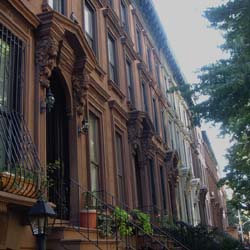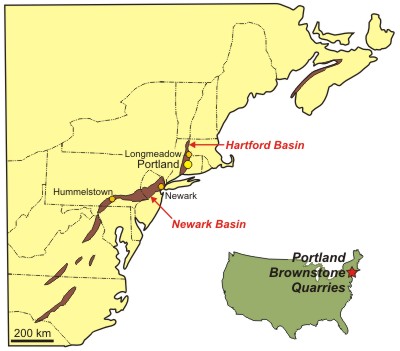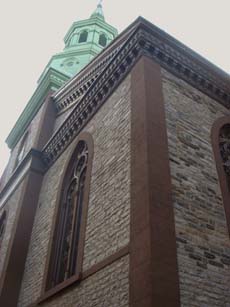PORTLAND BROWNSTONE

Trinity Church
|
PORTLAND BROWNSTONE |
|
|
| Official Name: | Portland Formation (Newark Supergroup) | |
| Location: | Connecticut River Valley, southern CT | |
| Age: | Early Jurassic (335-340 Ma) | |
| Lithology: | Sandstone (Feldspathic Arenite) | |
| NYC Examples: | Brownstone
Row Houses, Castle Clinton, Trinity Church |
|
 |
Deposits of reddish-brown sandstone lie in long, narrow bands along the eastern seaboard from Nova Scotia to North Carolina. In the band of sandstone-bearing rock known as the Hartford Basin, settlers of the Connecticut River Valley used sandstone boulders weathered from the Portland Formation for building as early as1650. Actual quarrying of Portland Brownstone began in 1725, and reached its peak in the mid- to late 1800's. The 1880 federal census tally
of NYC buildings, reported that 78.6% of stone buildongs used brownstone,
in whole or in part. The prevalence of Portland sandstone for construction
during this era lead to the term "brownstone" being synonymous
with "rowhouse" in the northeastern US. |
| Portland sandstone might be associated most directly with the rowhouse of the late 1800's, but many of the earliest buildings and monuments preserved in New York City incorporate this distinctive stone. Examples of Portland Brownstone can be seen in early churchyards, and in the pediments, quions, lintels and sills of such early churches as St Paul's Chapel (Lower West Side) and the Church of the Transfiguration (Lower East Side). | ||
 |
 |
 |
|
Headstone at
Trinity Church |
St. Paul's
Chapel
(1766) |
Church of
the Transfiguration
(1801) |
|
Most brownstone was quarried in Portland (CT), where individual, near-horizontal beds are approximately 0.7 to 6 meters thick, and have a total thickness of 1000 meters. Smaller quarrying operations existed in Longmeadow (MA), Newark (NJ), and Hummelstown (PA), but these deposits were smaller, and consisted of sandstones of variable color and quality in steeply dipping beds that were difficult to quarry. The color variability of the Newark Brownstone is well displayed in Lower Manhattan's Trinity Church. |
 |
|
Newark Brownstone in Trinity
Church (1839-1846) |
| GEOLOGICAL FEATURES OF THE PORTLAND BROWNSTONE | |
|
The Portland Brownstone is a coarse sandstone (feldspathic arenite), with feldspar content as high as 65%. Quartz and mica comprise most of the remainder of the rock. These detrital components were eroded from Ordovician gneisses and schists of Connecticut's adjacent Eastern Highlands. Albite cements the sand grains. The red color is due to iron oxides. Freshly quarried sandstone tends to be yellow-brown due to the presence of limonte. Dehydration of the quarried rock due to extended exposure to the air, results in conversion of limonite (FeO[OH]) to hematite (Fe2O3). The distinctive red-brown color of brownstone is due to the presence of hematite. |
 |
| Brownstone
was commonly face-bedded—that is, the rock was cut parallel
to the bedding, and slabs were applied so that the bedding is vertical,
and parallel to the wall. This means that the same bed is exposed across
the whole block, thereby ensuring that the color and texture was uniform.
Unfortunately, as soon
as a decade or two after construction, many examples of face-bedded brownstone
began flaking off in sheets. This common form of is due to the physical
weathering process of spalling due to frost action. Water
concentrates along bedding planes. When it freezes, water expands by approximately
10%. This expansion exerts a pressure of 2,000 psi, which pries off thin
layers of rock. |
|
|
The common problem of spalling
may have been due to hasty construction rather than an inherent fault
with the rock itself. Rock from Portland was quarried from depths below
the water table. Therefore, water filled the stone's pores. Initially,
stone quarried from Portland was allowed to "season"—that
is it was left to dry out gradually. During the housing boom of the late-1800's
the demand for Portland Brownstone exceeded the supply. |
|
|
Accordng to Mike Meehan, a geologist who re-opened a Portland Brownstone quarry in 1993, "Face-bedded stone, still full of water, was routinely applied to many of the 50,000 row houses built during the late 1800's. If it was done late in the season, just as freezing set in, the stone's disintegration was assured." Naturally bedded stone, is that in which the rock is cut perpendicular to the bedding. This type of application exposes many beds within an individual slab, possibly exposing variations in grain size, color and texture. It is also more difficult to cut, and therefore more expensive. However, naturally bedded stone is more resistant to weathering. |
|
|
ENVIRONMENT OF FORMATION In the Late Triassic time (~ 220 million years ago) to Early Jurassic, North America began to rift away from the rest of Pangea. A series of normal faults broke the mountainous region into a series of elongate ridges and valleys. As the valley floors dropped, rivers swept sediments eroded from adjacent highlands into the lowlands where large lakes developed during periods when the climate was wet. During extended dry periods, the fault-bounded lakes shrank and stream channels migrated across the valley forming broad alluvial plains. Wedges of sand and coarser sediments accumulated in alluvial fans adjacent to the valley's border faults, and later lithified to form coarse sandstones and conglomerates. Coarser sediments decrease towards the center of the basins, whereas beds of fine sand, silt and mud become more abundant. |
|
|
|
| During the Early Jurassic, when the Portland Formation was deposited, the climate was such that the region had a pronounces rainy season. Severe downpours resulted in streams carrying large sediment loads westward from the highlands into the fault valleys where the sediments accumulated in large alluvial fans at thw base of the fault scarp. The Portland Brownstone was deposited in the mid-fan region of one of these alluvial fans. The physical environment of Portland Formation deposition is represented in the block diagram, above. | |
© 2005 Wayne G. Powell